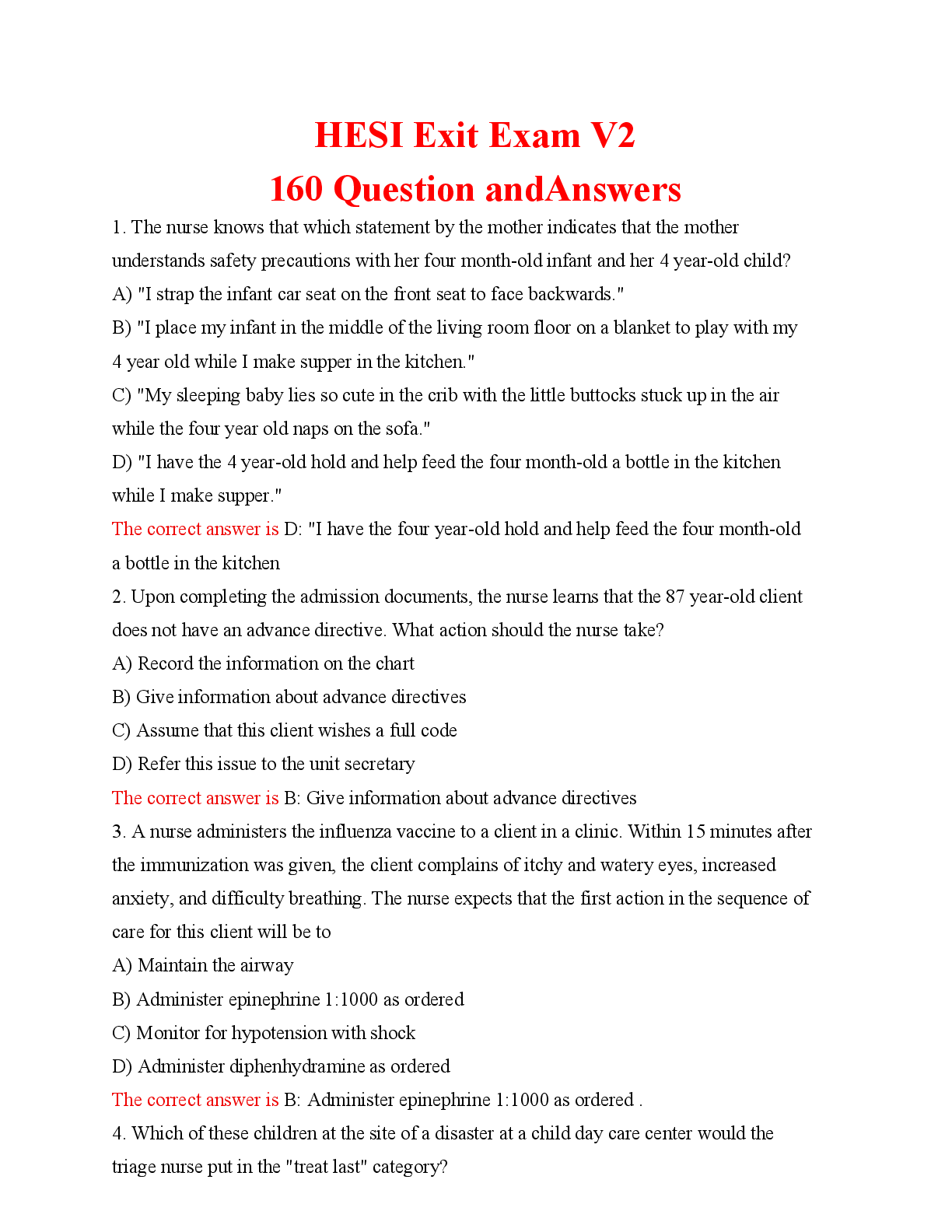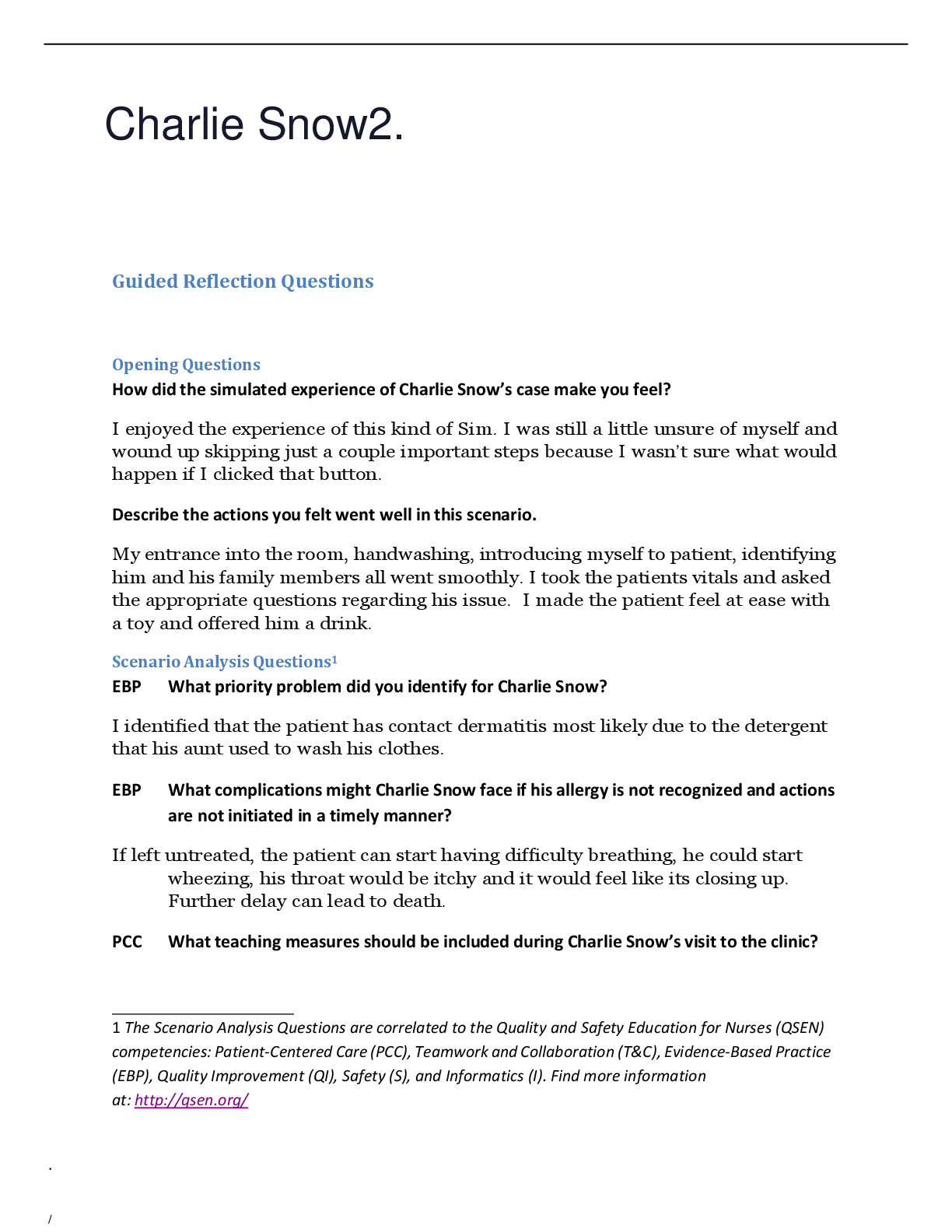Psychology > EXAM > PSYC 255 Quiz 5 2020(Real quiz) (All)
PSYC 255 Quiz 5 2020(Real quiz)
Document Content and Description Below
PSYC 255 Quiz 5 2020(Real quiz) Course Summer 2020 PSYC 255- Test Quiz 5 Started 8/6/20 11:03 PMLATE Submitted 8/6/20 11:46 PMLATE Due Date 8/3/20 11:59 PM Status Completed Comments Due 8/3. Uploaded ... 8/6. Ten percent points reduction per the late policy from the Psychology Department. -6 8/7/2020 Attempt Score 60 out of 60 points Time Elapsed 43 minutes out of 1 hour Instructions • Time limit: 1 hour • 30 multiple-choice questions • Open-book/open-notes • Do not hit the BACK button as this will lock you out of the quiz. • The timer will continue if you leave this quiz without submitting it. Results Displayed Submitted Answers, Feedback • Question 1 2 out of 2 points Betsy is conducting a study on school psychologists. She is thinking of having school psychologists complete four experimental conditions each lasting one hour. A colleague suggests to Betsy that she modify the design so that different groups of school psychologists are used and Betsy will not have to worry about __________. • Question 2 2 out of 2 points Tamir et al. (2008) conducted a study to see what impact music has on participants playing computer games. The researchers had participants play computer games while listening to angry, exciting, and neutral music. The researchers then measured the participant’s performance while listening to each type of music. This is an example of what type of design? • Question 3 2 out of 2 points Carefully review the research matrix presented below. If this is a within subjects design, how many total participants will be used in the experiment? No Caffeine 8 Ounces 24 Ounces 10 participants 10 participants 10 participants • Question 4 2 out of 2 points Carefully review the research matrix presented below. If this is a between subjects design, how many total participants will be used in the experiment? No Caffeine 8 Ounces 24 Ounces 10 participants 10 participants 10 participants • Question 5 2 out of 2 points Carefully review the research matrix presented below. If this is a within subjects design, how many total participants will be used in the experiment? Rock Music Group Rap Music Group Hip-Hop Music Group 30 participants 30 participants 30 participants • Question 6 2 out of 2 points We discussed a study known as the Stroop effect. Stroop developed 3 types of stimuli for his study. Each type of stimuli presented a different task that participants had to complete. Stroop then measured the amount of time it took the participants to complete each task. What is the dependent variable in this study? • Question 7 2 out of 2 points The degree of spread among data when surrounding the mean is known as __________. • Question 8 2 out of 2 points Barlett et al. (2005) selected a between subjects design to study the influence of action figures on male body image. Which of the following reasons listed below is not a reason why Bartlett and colleagues would have selected the design? • Question 9 2 out of 2 points What kind of study uses a methodology in which participants are matched on a particular characteristic before being assigned to the different levels of the independent variable? • Question 10 2 out of 2 points Which of the following is an advantage to a between subjects design? • Question 11 2 out of 2 points During the late 1980s and the early 1990s the Pepsi Challenge was in full swing. During the challenge, participants were asked to taste cola from both Coke and Pepsi. Once they had tasted both drinks, the participants were asked to report which was better tasting. The results indicated that participants found Pepsi products to be better tasting. This is an example of what type of research design? • Question 12 2 out of 2 points Darley and Batson conducted a study in which the independent variable was the degree to which the participants were instructed to hurry to the other building (high-hurry, intermediate-hurry, low-hurry) and the dependent variable was the amount of help offered to a “victim” placed by the researchers between the two buildings. This was a between subjects design. Therefore, how many groups of participants were needed? • Question 13 2 out of 2 points To combat order effects that may occur with a within subjects design, many researchers will use _____________. • Question 14 2 out of 2 points Janiszewski and Uy (2008) conducted an experiment in which they had 43 participants read 10 scenarios. All 43 participants each read all 10 scenarios. In this study, the researchers wanted to determine the impact of the scenario type on the anchoring and adjusting of participants. Anchoring and adjustment occurs when people use a starting point (anchor) as a basis to make judgments about a given scenario (adjustment). This is an example of what type of design? • Question 15 2 out of 2 points _________ occurs when the effects of a prior condition influence subsequent treatment conditions. • Question 16 2 out of 2 points You want to replicate Barlett et al.’s research on action figures and negative body image in young adult males. Your independent variable has three levels: no action figures, highly muscular figures, and moderately muscular figures. You want to conduct a between subjects design. How many total participants will you need if you want 10 participants in each level of the IV? • Question 17 2 out of 2 points Suppose we used a between subjects design to see if caffeine influenced levels of alertness. We had three groups of participants: participants who received 8 ounces of a caffeinated beverage, participants who received 24 ounces of a caffeinated beverage, and participants who received no caffeine. If this was a between subjects design with 30 total participants, how many participants would be in each condition? • Question 18 2 out of 2 points Which disadvantage to within subjects designs involves a participant dropping out of a study or not returning to complete additional parts to a study? • Question 19 2 out of 2 points Dr. Herrman recommends that his students take the practice GRE before registering to take the real GRE. Dr. Herrman makes this recommendation because he knows that __________ can increase performance on subsequent experiences with the same tasks. • Question 20 2 out of 2 points Katie is conducting a within subjects design. Her independent variable has 2 levels that must occur 1 week apart. In the first session during the first week, Katie has 120 participants. However, a week later when the second session occurs, Katie only has 85 participants show up for the study. What disadvantage to within subject designs is Katie encountering? • Question 21 2 out of 2 points A _____________ design exposes participants to all levels or conditions of the independent variable. • Question 22 2 out of 2 points The degree of spread among data surrounding the mean is known as _____________. • Question 23 2 out of 2 points Stacy has been working hard to look at the effects of homework difficulty on student desire to finish the work. She has decided to make sure that each group is equivalent on enthusiasm for school by measuring overall levels. Stacy then pairs up the participants based on their enthusiasm before placing them into the groups in her study. Stacy is conducting a _____________ design. • Question 24 2 out of 2 points You want to replicate Barlett et al.’s research on amount of blood in a video game and measures of aggression. Your independent variable has 4 levels: maximum blood, medium blood, low blood, and no blood. You want to conduct a between subjects design. How many total participants will you need if you want 10 participants in each level of the IV? • Question 25 2 out of 2 points During the late 1980s and the early 1990s the Pepsi Challenge was in full swing. During the challenge, participants were asked to taste cola from both Coke and Pepsi. Once they had tasted both drinks, the participants were asked to report which was better tasting. The results indicated that participants found Pepsi products to be better tasting. What is the independent variable in this study? • Question 26 2 out of 2 points In a within subjects design, all participants are exposed to all levels of the independent variable. A major concern to the participants going through all levels of the independent variable is becoming tired of participating in the study. What disadvantage is being described here? • Question 27 2 out of 2 points Tamir et al. (2008) conducted a study to see what impact music has on participants playing computer games. The researchers had participants play computer games while listening to angry, exciting, and neutral music. The researchers then measured the participant’s performance while listening to each type of music. What is the dependent variable in this study? • Question 28 2 out of 2 points Which of the following is not a disadvantage of a within subjects design? • Question 29 2 out of 2 points During the late 1980s and the early 1990s the Pepsi Challenge was in full swing. During the challenge, participants were asked to taste cola from both Coke and Pepsi. Once they had tasted both drinks, the participants were asked to report which was better tasting. The results indicated that participants found Pepsi products to be better tasting. What is the dependent variable in this study? • Question 30 2 out of 2 points We discussed a study known as the Stroop effect. Stroop developed 3 types of stimuli for his study. Each type of stimuli presented a different task that participants had to complete. Stroop then measured the amount of time it took the participants to complete each task. What is the independent variable in this study? [Show More]
Last updated: 2 years ago
Preview 1 out of 12 pages

Buy this document to get the full access instantly
Instant Download Access after purchase
Buy NowInstant download
We Accept:

Reviews( 0 )
$15.00
Can't find what you want? Try our AI powered Search
Document information
Connected school, study & course
About the document
Uploaded On
Apr 22, 2021
Number of pages
12
Written in
Additional information
This document has been written for:
Uploaded
Apr 22, 2021
Downloads
0
Views
52














